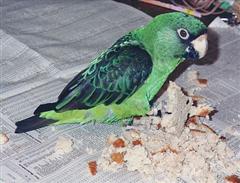Parrot - Green Hanging
Red Billed Hanging Parrot Scientific Name: Loriculus exilis
Fri, 1st November, 2024 - 4:27 am GMT
Sponsor Ads:

Alternative Name
Red Billed Hanging Parrot Scientific Name: Loriculus exilisBasic Info
By maturity, most Green Hanging Parrots grow to four inches (ten and a half centimeters) in length. Their plumage is predominantly green, with yellow hints on their under-parts. There is a long red patch on the throat, which is reduced or absent in female and juvenile Green Hanging Parrots. The upper tail coverts and the rump are also red. These areas often have a yellowish tint. The feathers of the neck are greenish blue, as are the under - wing feathers. The tops of the wings of Green Hanging Parrots are darker green. The tail shows a similar coloration to the wings, save for the outer feathers, which are tipped in a greenish yellow color. Green Hanging Parrots have red bills, tipped in yellow, and their feet are an orange yellow or flesh color. The irises of males are yellow, and the irises of females and juveniles are brown. Juvenile Green Hanging Parrots also have yellow brown bills.
Health
Usually, the aviary for a Green Hanging Parrot should be six by three by six feet (two by one by two meters). The temperature should never fall below 77 degrees Fahrenheit (25 degrees Celsius) during acclimation. Later, temperatures should remain above 68 degrees Fahrenheit (20 degrees Celsius). Green Hanging Parrots should be misted daily. Green Hanging Parrots should be provided with plenty of hiding places to reduce stress. They enjoy bark stripping, and willow or elder branches should be provided regularly. Green Hanging Parrots should be fed a nectar solution made from porridge, honey, and pollen. They should be allowed plenty of fresh fruit like figs, bananas, and soft pears. Lory food or porridge, sprouted oats and millet, and fresh branches in bloom should also be offered. Breeding There are no recoded captive breedings of Green Hanging Parrots. In the wild, these birds breed in February and August and make their nests in dead palm trees. Not much is known about wild breeding.Habitat
Green Hanging Parrots prefer to remain in the tops of trees and are most commonly seen in forests or mangrove woods.Behavior
Little is known about the beautiful and secretive Green Hanging Parrot. Difficult to keep in aviculture, these birds are a joy to those that are able to care for them. Green Hanging Parrots feed on flowers and sometimes nectar. They are nomadic, moving to areas where trees are flowering as this food comes in season. Usually they are seen alone or in small family groups. Some are seen in pairs. Occasionally they can be seen in more open areas, as long as there are plenty of trees in these areas to shelter the parrots. Green Hanging Parrots were not noticed widely by observers until about 1968. This is probably due to their secretive habits, quiet natures, and close semblance to the Sulawesi Hanging Parrot. They fly very quickly, and their call is a soft hissing noise. They are very quiet and docile in aviculture, where they are rare and considered rather difficult to care for.Origin
IndonesiaHistory
The Green Hanging Parrot was first noted by Schlegel in 1866. These parrots are native to Sulawesi and the Celebes Islands in Indonesia. They are found in forests or wooded areas below 3,300 feet (1,100 meters) in altitude. Although Green Hanging Parrots are adored by many aviculturalists for their beauty and their quiet natures, they often die suddenly for no apparent cause and may be difficult to acclimate. They are not good beginners' birds.Common Foods
N/ASponsor Ads:
Boyle's Observation: A welfare state is one that assumes responsibility for the health, happiness, and general well-being of all its citizens except the taxpayers.
Parrot - Green Hanging
Coded by: BGID® | ALL RIGHTS RESERVED Copyright © 2000-2024
Disclaimer | Privacy | Report Errors / Contact | Credits








 Homosexual behavior stems from the mind or genetics?
Homosexual behavior stems from the mind or genetics?  The Best Text Adventure You Will Ever Play! The official site:
The Best Text Adventure You Will Ever Play! The official site:  Why haven't we as a collective earth met with aliens yet?
Why haven't we as a collective earth met with aliens yet?  World EcoSystem - Biodiversity Changes - Who is on board and who isn
World EcoSystem - Biodiversity Changes - Who is on board and who isn  Mouthwash - Mouthrinse - Mouth Sores - Healing Infections - Gingivitis
Mouthwash - Mouthrinse - Mouth Sores - Healing Infections - Gingivitis  Treatment for Depression
Treatment for Depression  Ultra radical and violent Islamist group that even rivals Al Qaeda
Ultra radical and violent Islamist group that even rivals Al Qaeda  An idea to have teachers who want to carry guns to school undergo some level of police training will be left up to local school districts and police departments.
An idea to have teachers who want to carry guns to school undergo some level of police training will be left up to local school districts and police departments.